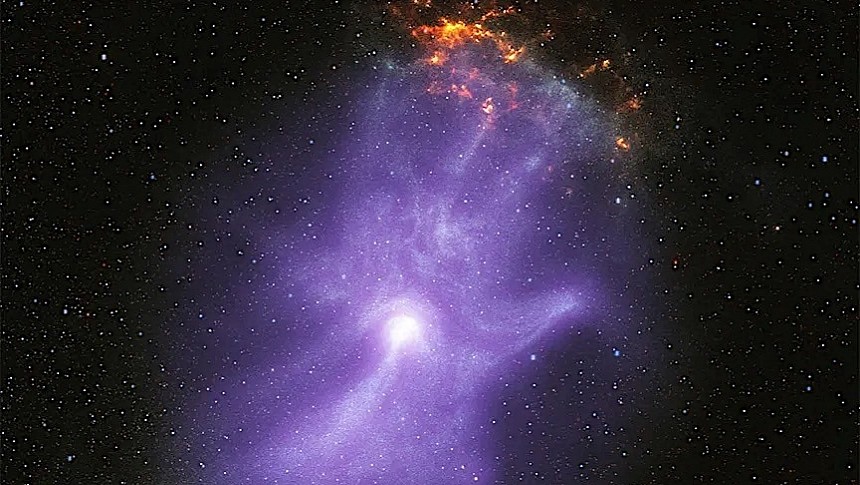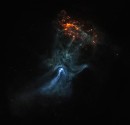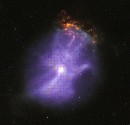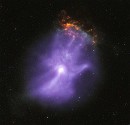NASA only planned to squeeze around five years of service out of its Chandra X-ray Observatory. But almost 25 years after departing the payload bay of Space Shuttle Columbia, valuable information about the cosmos is still collected by the probe every year. Every once in a while, Chandra gets to share some truly spectacular photographs among the terabytes of technical data the probe processes in a given day. But we doubt there's a person out there who thought Chandra would deliver such a spooky image just in time for Halloween.
Well, it'd be wrong to say it was all Chandra's doing. NASA's newest X-ray telescope in low-Earth orbit, IXPE, helped create this latest image as the twin probes set their sensors on a pulsar emission 16,000 lightyears away from our Solar System. At this location, pulsar PSR B1509-58 is still visibly suffering the effects of a long-dead star's violent demise. According to NASA, at least 1,500 years have passed since a star of unknown mass breathed its final breaths of nuclear fuel before its considerable mass of plasma and gas collapsed in on itself, unable to sustain fusion any longer.
Without enough mass to go full supernova, the resulting collapse gave birth to a pulsar, a rapidly spinning neutron star more dense than our Sun but small enough to fit in the average large city. Such biblical levels of mass condensed into such a tiny space forces titanic levels of electromagnetic radiation out from the pulsar's magnetic poles. It's these bolts of radiation's interaction with surrounding cosmic dust, called a pulsar wind nebula that contributes the most to the hand-like appendage poking out of the inky-black beyond of interstellar space.
Like a mythological gream reaper here to collect the soul of the star that once resided in this spot, Chandra and IXPE captured the inner machinations of the universe playing out in a way that feels almost like divinity. Because of the vast distance away from this particular pulsar, the remnants of a stellar death from back in the 6th century AD will likely remain this vibrant and eye-catching on the X-ray spectrum for thousands of years into the future. Assuming any semblance of sentience is around in the future to observe it, that is.
"The IXPE data gives us the first map of the magnetic field in the ‘hand’," said Roger Romani of Stanford University in California. It was Romani who led the NASA initiative to unearth the mystery of why Chandra and IXPE observed pulsar PSR B1509-58 behaving in a way that legitimately looks like something out of a Nightmare Before Christmas. "The charged particles producing the X-rays travel along the magnetic field, determining the basic shape of the nebula like the bones do in a person’s hand."
It's because Chandra and IXPE capture X-ray signatures from such vast distances away that we can observe these gusts of pulsar radiation take a form resembling a human hand with currents of cosmic dust for fingers. Is it an omen of chaos soon ahead? Or some form of divine hand? Ultimately, that's up to the clergy to decide, not scientists. But that's not to say there's not a breadth of knowledge to be learned by marveling at Chandra and IXPE's observations, even when they aren't capturing spooky ghost tendrils in space.
"We’ve uncovered the life history of super energetic matter and antimatter particles around the pulsar,” explained project co-author ?Niccolò Di Lalla, also of Stanford. “This teaches us about how pulsars can act as particle accelerators." With this in mind, a pulsar's electromagnetic ejecta behaves in a very similar manner to man-made particle accelerators here on Earth, like the Large Hadron Collider in Switzerland. In both cases, massive electromagnetic fields are responsible for manipulating ionized subatomic particles to the point they propel themselves at speeds and directions they wouldn't otherwise travel.
By harnessing similar forces to that which occur in the heart of a rapidly-spinning neutron star through contemporary nuclear fusion research, scientists and engineers hope to one day supply the world with enough clean-burning, carbon-free energy to last into the far future. Just by observing the swirling red ribbons of plasma generation by the average Tokomak-class fusion reactor, one can't help but how uncanny it looks to the swirling torrents of radiation emitted from a pulsar. At the end of the day, the same laws of physics that govern modern commercial nuclear fusion are responsible for the wonderous aftermath of a massive star taking its last mortal breaths.
As for Chandra and IXPE, they won't be going anywhere anytime soon. NASA intends to operate Chandra well into the future, despite its age, while IXPE's still less than two years into its planned five-year operational life as of November 2023. Safe to say, chances are good the two probes will photograph something just as spectacular in time for next Halloween.
Without enough mass to go full supernova, the resulting collapse gave birth to a pulsar, a rapidly spinning neutron star more dense than our Sun but small enough to fit in the average large city. Such biblical levels of mass condensed into such a tiny space forces titanic levels of electromagnetic radiation out from the pulsar's magnetic poles. It's these bolts of radiation's interaction with surrounding cosmic dust, called a pulsar wind nebula that contributes the most to the hand-like appendage poking out of the inky-black beyond of interstellar space.
Like a mythological gream reaper here to collect the soul of the star that once resided in this spot, Chandra and IXPE captured the inner machinations of the universe playing out in a way that feels almost like divinity. Because of the vast distance away from this particular pulsar, the remnants of a stellar death from back in the 6th century AD will likely remain this vibrant and eye-catching on the X-ray spectrum for thousands of years into the future. Assuming any semblance of sentience is around in the future to observe it, that is.
"The IXPE data gives us the first map of the magnetic field in the ‘hand’," said Roger Romani of Stanford University in California. It was Romani who led the NASA initiative to unearth the mystery of why Chandra and IXPE observed pulsar PSR B1509-58 behaving in a way that legitimately looks like something out of a Nightmare Before Christmas. "The charged particles producing the X-rays travel along the magnetic field, determining the basic shape of the nebula like the bones do in a person’s hand."
"We’ve uncovered the life history of super energetic matter and antimatter particles around the pulsar,” explained project co-author ?Niccolò Di Lalla, also of Stanford. “This teaches us about how pulsars can act as particle accelerators." With this in mind, a pulsar's electromagnetic ejecta behaves in a very similar manner to man-made particle accelerators here on Earth, like the Large Hadron Collider in Switzerland. In both cases, massive electromagnetic fields are responsible for manipulating ionized subatomic particles to the point they propel themselves at speeds and directions they wouldn't otherwise travel.
By harnessing similar forces to that which occur in the heart of a rapidly-spinning neutron star through contemporary nuclear fusion research, scientists and engineers hope to one day supply the world with enough clean-burning, carbon-free energy to last into the far future. Just by observing the swirling red ribbons of plasma generation by the average Tokomak-class fusion reactor, one can't help but how uncanny it looks to the swirling torrents of radiation emitted from a pulsar. At the end of the day, the same laws of physics that govern modern commercial nuclear fusion are responsible for the wonderous aftermath of a massive star taking its last mortal breaths.
As for Chandra and IXPE, they won't be going anywhere anytime soon. NASA intends to operate Chandra well into the future, despite its age, while IXPE's still less than two years into its planned five-year operational life as of November 2023. Safe to say, chances are good the two probes will photograph something just as spectacular in time for next Halloween.






